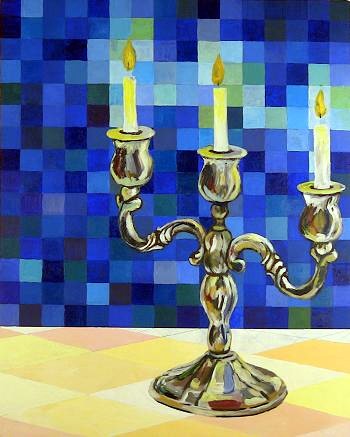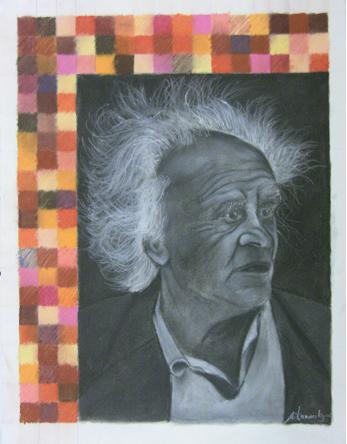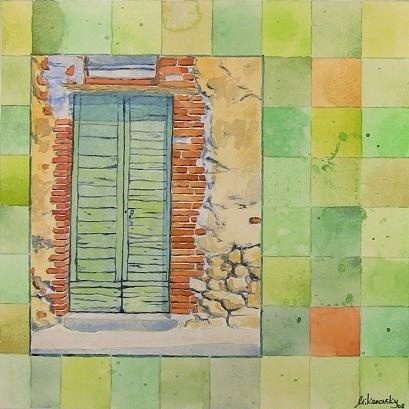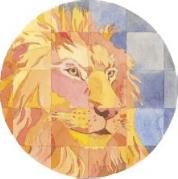
Blessing of the House, Watercolors, 1995
– As a kid, I remember filling page after page of math notebooks with colors. The math notebooks in Israel of my childhood had 40 pages, were about 20 by 30 centimeters, with simple blue-lines grid. Like some type of therapy, I patiently and painstakingly filled page after page with colorful patterns. Probably none of these survived till today…
– While learning art history, one of the main methods described to copy art or to enlarge sketches into big canvases, was by using a grid to divide the surface to smaller components, which makes copying each part easier. I must admit – I never tried it… It looked too “boring” for me to use. But it is a great mechanism, used by many of the masters. There are some master unfinished paintings that the grid is still shown in the museums around the world. What I found intriguing in these paintings was that the grid not covered and hidden by the painting and the viewer can still see it. I loved the exposed feeling it gave to the painting.

Candelabra, Acrylics on canvas, 2000
– I always loved grid-work art. Some artists that influenced me are:
- Piet Mondrian, whose compositions with basic black grid and blue-red-and-yellow squares and rectangles always intrigued me to imagine what is beyond the image, and what they represent beyond their abstract look.
- Michael Eisemann, an Israeli artist whose prints you can find almost in every second office, restaurant or home in Israel. I can say that his style probably influenced me the most to start using the grid, but I had to add color to each individual square, where his grids always stays with a sandy beige color. Also my neat and organize personality doesn’t allow my (now anyway) to use a loose style such as Eisemann, whose paintings’ are filled with freehand doodling. Many online Israeli galleries offer his prints, and I choose this example, but you can find his prints everywhere.
- Cubist artists, and their pre-cursor, Paul Cézanne. My art teacher back in Avni Institute – College for Art and Design in Jaffa was literally in love with Cezanne and his work. She loved the way he built his images, one stroke at a time, like a building constructed from shapes in different colors. I guess that she instilled in me first the love for everything Cezanne, but more than that, the adventure of exploring shapes and colors and their relationships when placed next to each other. I can strongly see that happens now in my current style, where the squares are not just background around a main image, but define the shapes that builds the image of each object.

Old Man, Conté Crayons, 18" x 24", 2002
– My love to architecture, and more specifically, ancient architecture. Israel is a heaven for anyone who loves archeology and ancient ruins. One of the main features I love in them is the mosaic floors. Built out of thousands of tiny squares, some has such intricate and delicate design, you have to see it for yourself to believe it is actually built out of small stone or glass. Other architectural details that always capture my eye and my imagination, are stained-glass windows, and decorated tiles. I received lately some comments that my artwork looks like old tiles or has some stained glass quality. And its right. Because these are some of the things I just love!

Green Door, Watercolors, 11.5''x11.5'', 2008
– And last, but not least, the search for the perfect square. Why would anyone search for the perfect square? Well, when you learn to draw or to paint, some of the exercises are to draw squares and fill them up with different values of hues. I was always fascinated by these exercises, that the colors I used were never perfect through and throughout. Why to look for this perfect squares? I have no idea really. But as long as I am not tired of the search, and as long as people like my style, why not? What is next? I am just starting touching the surface with my squares, and love it when people see it as my signature style. I have many ideas on how to develop it, but I will let time and the artwork to lead me on this great journey.
Sincerely yours
Moshe

- Leo, detail from 2odiac, Watercolors, 7”x7”, 2009
PS While writing this post, I found it is quite personal to explain why I do what I do. More than explaining about the themes and inspiration for my art, trying to explain my style took me to places I never wrote about before. So here it is, and I hope you share my love for art.
Other related articles on my art inspiration: Art Blog Beginnings, or What Inspires My Art?

Hey Moshe
You answered my questions.
Very interesting post…
Benny
By: Benny on October 27, 2009
at 7:09 am
Thank you Benny,
I know this is one of the main question people usually ask me (or want to ask), why I love squares so much! So I had to put it down in writing and share.
Thanks again for the comment
Moshe
By: Moshe Mikanovsky on October 27, 2009
at 9:17 am
I really took the time to read this particular blog of yours. I found it quite interesting reading the reasons behind why you create art in the style of squares and I found the consistency of the square to be what sets your style of art appart from others. It really is your own little signature on the world. It defines your work in a way that will make people say ‘ that is Moshe Mikanovsky distinctive style and I like it!’
By: M halberstadt on October 27, 2009
at 7:53 am
Thank you for your comment M H,
This post was always in my mind to write, and it took me few weeks to just put it down, with lots of changes and revisions. That’s probably because of the nature of trying to explain something so personal as art style.
I hope to expand on it in the future, as I grow with my style and art.
Thanks again,
Moshe
By: Moshe Mikanovsky on October 27, 2009
at 9:21 am
Thank you for sharing this Moshe. I find your style very unique and distinctive. Knowing more about how you’ve developed your style helps me appreciate even more. Its very beautiful.
By: theresa on October 27, 2009
at 9:20 pm
Thank you Theresa for the kind comments!
I find it fascinating how few words about the art can make the difference for people to understand it. Its a great journey I love taking!
Thanks again
Moshe
By: Moshe Mikanovsky on October 28, 2009
at 1:06 pm